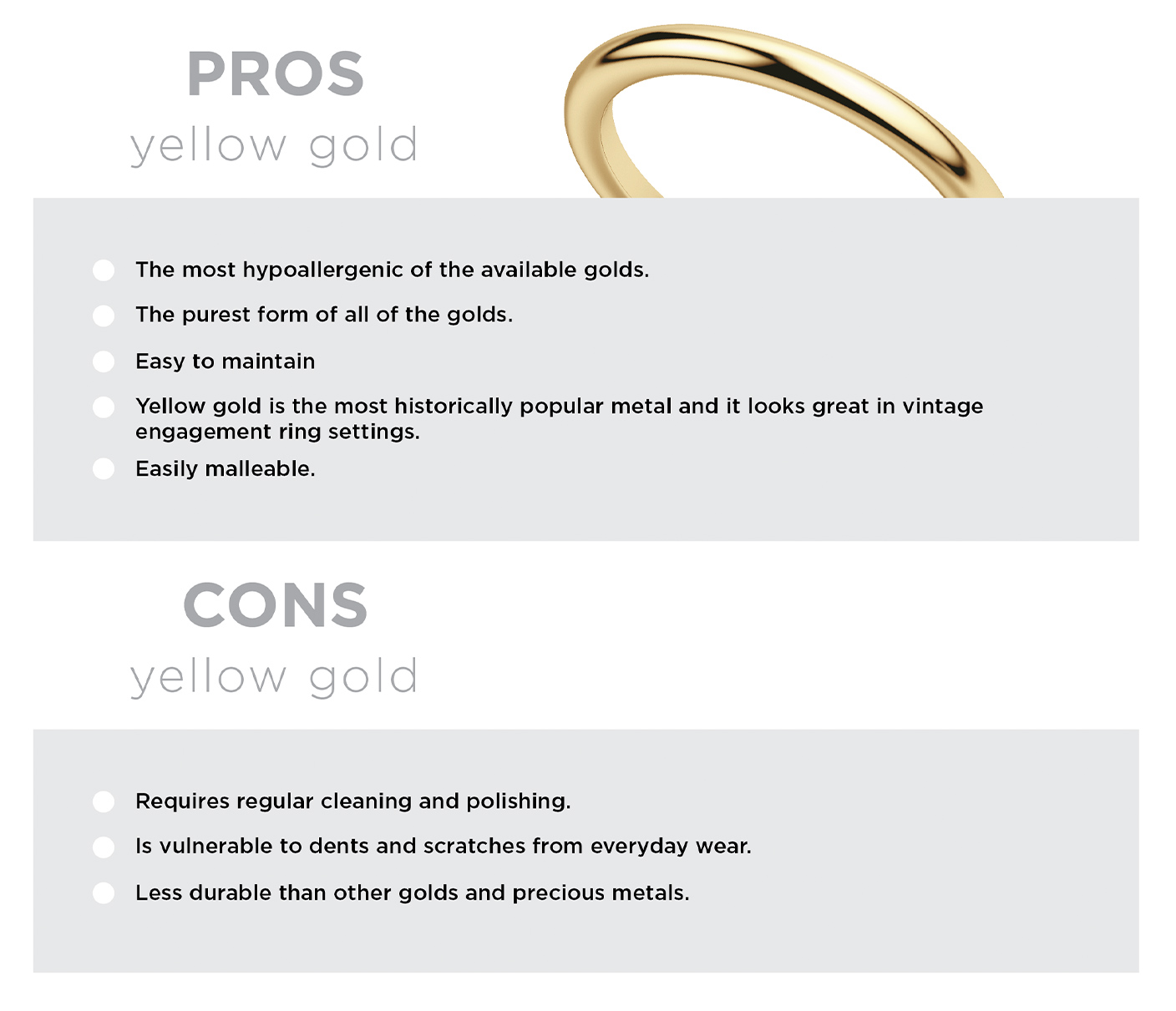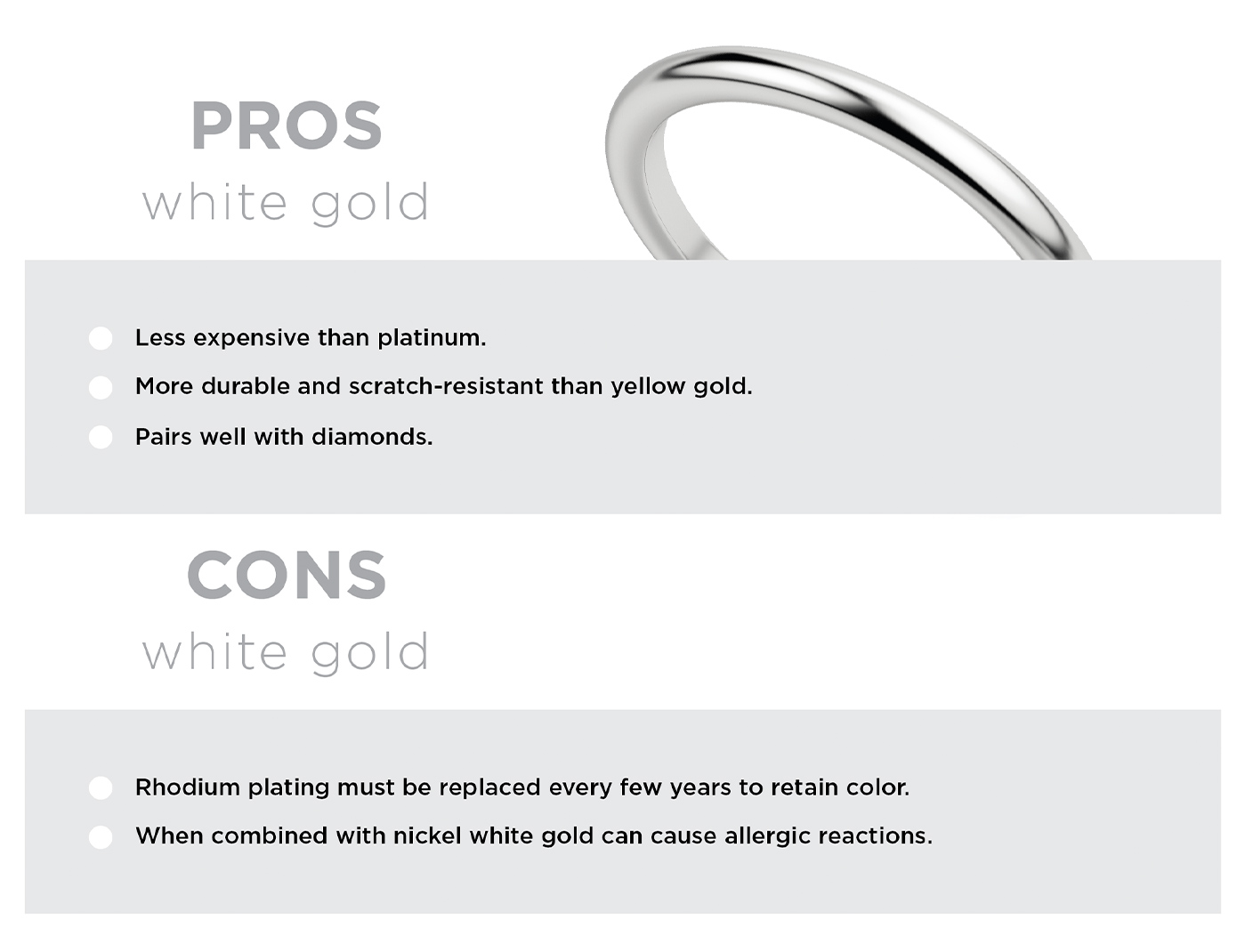Is White Gold More Expensive Than Yellow Gold? A Comprehensive Value Analysis
November 13th, 2023 / Alese Oldenburg
Two timeless classics, you might be wondering what sets a yellow gold ring and white gold ring apart. While each gold is distinctly different visually speaking, is there much of a discrepancy in things like durability, quality, and chemical makeup? And of course, the big question on everyone’s mind is, what about the cost? Is one type of “gold” more valuable than the other?
Here, we will discuss the pros and cons of each precious metal as well as the key differences between the two metal types to help you understand everything that you need to know before making your engagement ring or fine jewelry purchase.

What Is Yellow Gold?
When it comes to white gold vs yellow gold, yellow gold consists of a mixture of pure gold and alloy metals like copper and zinc. The amount of pure gold a jeweler uses in a piece of jewelry depends on overall karat weight. A higher karatage will consist of a purer gold content than a lower karatage. However, the more pure gold used, the less durable a ring will be. For this reason, 14-karat and 18-karat gold is most commonly used in yellow gold engagement rings and wedding rings as opposed to 24-karat gold which is too soft.
Pros & Cons of Yellow Gold

Pros
- Hypoallergenic Marvel: One of the standout features of yellow gold is its hypoallergenic nature. This makes it an ideal choice for those with sensitive skin, ensuring both comfort and style.
- Purity Personified: Renowned for its purity, yellow gold stands as the purest form among its counterparts. This inherent purity not only contributes to its warm, rich color but also establishes it as a symbol of uncompromised elegance.
- Maintenance Simplicity: Yellow gold takes the spotlight for its ease of maintenance. With minimal effort, it retains its radiant sheen, offering a hassle-free option for those who seek beauty without the need for extensive upkeep.
- Historical Allure in Vintage Settings: Delving into the annals of history, yellow gold emerges as the reigning champion of metals. Its historical popularity is mirrored in the timeless charm it brings to vintage engagement ring settings, creating a bridge between the past and present.
- Malleability Mastery: The malleability of yellow gold is a jeweler’s delight. This characteristic allows artisans to create intricate and detailed designs, turning each piece into a work of art that seamlessly adapts to diverse styles.
Cons
- Regular Care Rituals: To keep yellow gold at its gleaming best, regular cleaning and polishing are essential. This commitment to maintenance ensures that the metal continues to shine, showcasing its enduring beauty.
- Vulnerability to Wear and Tear: While yellow gold possesses a timeless charm, its susceptibility to dents and scratches from everyday wear is a consideration. Caution and care are recommended to preserve its delicate allure over time.
- Durability Considerations: In comparison to other golds and precious metals, yellow gold is deemed less durable. While it exudes elegance, those considering this metal should be mindful of its relative delicacy and factor in the need for gentle handling.
What Is White Gold?
White gold is created using a mixture of pure gold and white metals like palladium, silver, and nickel, usually in combination with rhodium plating. Although it requires other white gold alloys to increase its durability, white gold is still real gold.
The value of a white gold piece will vary depending on the karat weight and how much metal was used to craft the piece.
Pros & Cons of White Gold

Pros
- Cost-Effective Brilliance: A compelling advantage of white gold lies in its affordability compared to platinum, providing an accessible avenue for those seeking luxury without the premium price tag.
- Durability Beyond Comparison: White gold takes center stage in the durability arena, outshining its yellow counterpart. Its robust nature and resistance to scratches make it a practical choice for jewelry that stands the test of time.
- Diamond Harmony: A natural companion to diamonds, white gold sets the stage for these precious gems, enhancing their brilliance and creating a stunning contrast that captures the eye.
Cons
- Rhodium Maintenance: To retain its lustrous color, white gold often undergoes rhodium plating. While this enhances its aesthetic appeal, it requires periodic replacement every few years to maintain the desired hue.
- Potential Allergic Reactions: A consideration when working with white gold, especially when combined with nickel, is the potential for allergic reactions. Sensitivity varies among individuals, making it crucial to choose alloys carefully.
Is White Gold More Expensive Than Yellow Gold?
When it comes to price, variety is the key factor to consider. 10K, 14K, or 18K – the higher the concentration of gold, the higher the price tag. That being said, 18K gold is more prone to scratching and damage due to its high gold content.
That being said, it’s not uncommon to find white gold that is priced slightly higher than yellow gold. There are a few reasons for this. Firstly, in the 1990s, the popularity of yellow gold jewelry decreased amongst diamond engagement ring shoppers as platinum and white gold enjoyed a trending moment, thus driving up costs.
Secondly, white gold rings are dipped in rhodium plating to improve durability and create the beloved luster that white gold engagement rings are known for. However, this isn’t a one-time expense. White gold jewelry should get a new layer of rhodium every two to three years to keep it looking its best, especially if the piece is worn regularly.

Is White Gold Worth More Than Yellow Gold?
Again, the value of both white gold and yellow gold comes down to the gold content within the piece. For this reason, the two different metals are similar in worth. As we discussed above, white gold is created using pure gold and a variety of white color alloys. Regardless of the alloy, white gold must contain a minimum of 50 percent gold.
Your best bet to determine the true value of gold engagement rings and wedding bands is to visit your local jeweler or online retailer, where they can calculate how much gold you have and compare it to the current gold market price. However, keep in mind that rings aren’t a super fruitful investment, and they rarely hold their original value.

White Gold vs Yellow Gold: Which Is Better?
In all honesty, deciding between white gold and yellow gold jewelry usually comes down to personal preference. Both metals are tried and true favorites on the fine jewelry market, and both are sure to make for a lovely addition to your forever adornment. One tip to keep in mind if you’re stuck between the two is that cool skin tones tend to look nicer when paired with white gold or platinum jewelry, while warm skin tones look amazing in yellow and rose gold.
In the grand tapestry of jewelry choices, white gold and yellow gold stand out as perennial contenders, each with its unique charm. White gold, a contemporary blend of yellow gold and white metals like nickel or palladium, boasts a modern and sophisticated allure, making it an excellent choice for those seeking a sleek and versatile aesthetic. On the other hand, yellow gold, with its classic composition of pure gold and alloy metals like copper, emanates timeless warmth and richness, appealing to those who cherish a touch of vintage elegance. As you navigate the intricate world of fine jewelry, consider your personal style and the emotions each metal evokes, ensuring your choice resonates with the sentiment you wish to capture in your cherished pieces.
Alternatively, if you want the best of both worlds, opt for a mixed metal engagement ring setting or engagement stack.
Sources:
https://www.diamonds.pro/education/platinum-vs-gold/
https://www.diamondnexus.com/blog/white-gold-vs-yellow-gold/
*Here at Diamond Nexus, we strive to provide valuable information while being clear and honest about our products. The Nexus Diamond™ alternative is a patented lab created diamond simulate that, among all simulants, most closely imitates the look, weight and wear of a diamond, with two exceptions – it is absolutely perfect in every way, and it costs significantly less. Price points and environmental facts expressed in this blog were taken from popular online retailers and may vary. Learn more about the environmental impact of mining by visiting our blog.

